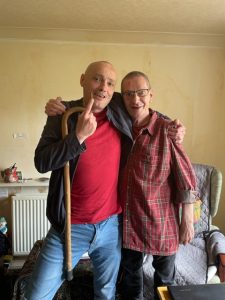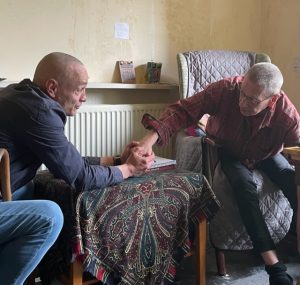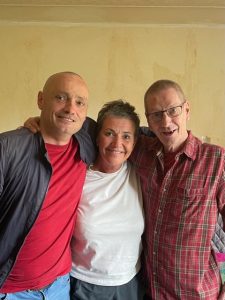
I have been on a personal mission for months to try and arrange a meeting between two guys I now have the privilege to call friends. Their paths have never crossed before, yet they have so much in common. They have both lived on the fringes of society. Both have been involved in crime, violence, and drugs. They have also had the misfortune of being homeless and victims of cuckooing. If that wasn’t enough, they both have something else in common.
They have both acquired brain injuries (ABI) due to car accidents.
All brain injuries are different, and the effects can vary hugely in nature and severity, depending on which part of the brain is affected and how badly. People with brain injuries can have a range of physical, cognitive, emotional or behavioural problems, and if ignored or misdiagnosed, can have a detrimental impact on the individual’s lives.
I’ve previously shared something called Post Traumatic Growth (PTG), which refers to the positive life changes that may come about from trauma or traumatic event, and these guys are perfect exemplars of PTG. Rather than let their disability hold them back, they have used it to propel themselves forward and transform them into the people they are today.
On the left is Tal – I met Tal when he joined us on one of our weekly recovery walks as part of National Recovery Month over five years ago. He was in recovery after being addicted to a cocktail of prescribed drugs. Unbeknown to Tal, his brain was a ticking time bomb, waiting to implode the acquired brain damage had been traced back to a car accident in his childhood.
Nowadays, when he’s not being filmed for a documentary about his life with an acquired brain injury (ABI), you will find him organising Tals Talent nights where he tries to raise funds for the Whirlow Trust, who work with kids who also suffer from brain injury. He has agreed with Hallam University to donate his brain for research purposes, in the hope, in his words, ‘it might help just one person’. Last year he filmed his personal experience of being cuckooed, which has been as part of a city-wide training package aimd at professionals.
On the right is Steph -I met Steph whilst on my quest to learn more about ARDB (Alcohol Related Brain Damage) I have written about this previously. Steph established and chairs the Homelessness and Traumatic Brain Injury Research Group, which aims to highlight the prevalence of traumatic brain injury amongst homeless people compared with the general population to highlight the need for more specialist support. You can read about their research here. Steph has also been working with Sheffield’s Changing Futures Program to train front-line practitioners in Adult Social Care and to develop a bespoke support pathway in the city.
We’d arranged to bring Stephen Windle, an independent filmmaker currently filming the documentary about Tal, to capture this meeting of two brain injury survivors talking about their personal lived experience, hoping that it can help raise awareness about ABI.
If I’m being honest, I was a bit nervous; all three of us could talk for England, and I wasn’t sure how it might go, especially with a camera set up in the living room. But I needn’t have worried because Tal and Steph bonded instantly; within five minutes, they were talking like they were the only two people in the room. A few tears were shed, but there was much more laughter, entwined with dark humour that only they have the authority to laugh about.
Turns out both have family links to Scotland and grew up in mining communities. They shared their highs and lows and talked candidly about how violence became a coping strategy for them and their shared love of Boxing. Tal’s face lit up in amazement and recognition when Steph confessed to being unable to feel physical pain since his accident. Tal was the same, so much so that in the past, he’d used this to his advantage when taking part in bare-knuckle fighting.

I see Tal flinch and clench his fist and wince when he talks about the memories from when he was cuckooed. Then, he turns to me and admits that he still can not talk about the torture he had to endure under the hand of his aggressors, which is tough coming from a guy who has fought in the army. However, the emotional scars remain.
They talked about how they’d always suspected something wasn’t right but, for years, felt fobbed off by a system that excluded them instead of supporting them. They vented their frustrations about all the missed opportunities by professionals who could have picked up on some of the symptoms earlier.
They joked about some of the scrapes they had gotten themselves into and the relief of not being able to feel pain. Like the time when Steph, who, after insulting a room full of Scottish Orange men, was physically thrown out of a moving coach, or Tal when he’d been stabbed whilst working the doors.
Steph remarked that Tal reminded him of Phineas Gage. Gage earned his place in the neurological hall of Fame after an accident resulting in a tamping iron going straight through his head.
The stigma they have both endured from society is off the scales; both have been labelled and written off as troublemakers and, in their words, caste aside like “junkies or alcoholics.”
You might have expected more talk about regrets or feeling bitter and angry, but there was none of that. Their faces lit up; they shared how the awful painful experiences they both had endured had been a blessing in disguise because had none of it happened, they wouldn’t be the people they are today.
I felt compelled to write about this meeting for two reasons. One was to help me process my own emotions following the meeting and, secondly, to hopefully help in a small way to raise awareness about ARB.
The meeting ended with Tal inviting Steph and his Wife to view the rough edit of the documentary, which is being shown to a select few people, on the account that Tal’s health is deteriorating rapidly and there is a chance that he might never see the final cut.
There was a famous quote by C.S Lewis saying
“Two heads are better than one, not because either is infallible, but because they are unlikely to go wrong in the same direction.”

And I could think of anything more fitting; both men are two of the most remarkable, humble and inspirational guys I have ever had the privilege to meet. hence the reason I couldn’t resist sharing this personal experience with you all.
Love Fordy
Remember
I don’t write for financial reward or gain. I just want to help share my lived experience with others hoping that it helps. And I just love to write, so if ya fancy getting the occasional email (NO SPAM) with the most up-to-date blogs from yours truly, please feel free to subscribe at the bottom of the main page.





Wow just wow! I have no word for how this made me feel when reading it. I didn’t know what cuckooing meant but deary me it just makes me dispare of the human race sometimes. They are so strong and brave ti have come through that and still smile and help others I’m in awe and I was nearly in tears cos id boiled my carots with no water!! puts life into perspective. Thanks so much for sharing their story.
Awe thank you for taking the time to read, honestly it was such an emotional meeting and I felt so compelled to share it, but also their stories in the hope I can do my bit to help raise awareness
Thank you for sharing this. I am very moved by bravery of the two of them in opening up, and wish them luck for what ever future they make.
Morning Alison,
How are you, can you imagine how emotional was being there in the room, hence me needing to share it – I hope you are keeping well and staying busy with your hobbies xx